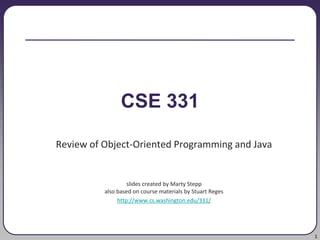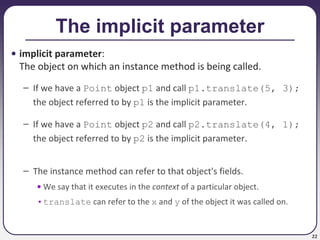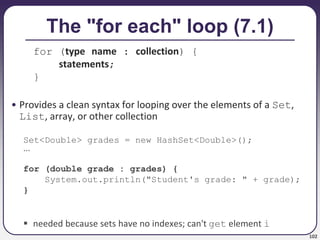This document provides a review of object-oriented programming concepts in Java, including:
- The difference between primitives and objects, and value vs reference semantics.
- How classes act as blueprints for objects, defining their data and behavior.
- Key object-oriented principles like encapsulation, fields, methods, and constructors.
- How objects pass by reference when used as parameters or assigned.
- Comparing objects requires special methods rather than using ==.



![4
A swap method?
• Does the following swap method work? Why or why not?
public static void main(String[] args) {
int a = 7;
int b = 35;
// swap a with b?
swap(a, b);
System.out.println(a + " " + b);
}
public static void swap(int a, int b) {
int temp = a;
a = b;
b = temp;
}](https://image.slidesharecdn.com/00-review-220729150951-43073772/85/00-review-ppt-4-320.jpg)

![6
Reference semantics (objects)
• reference semantics: Behavior where variables actually store the
address of an object in memory.
When one variable is assigned to another, the object is
not copied; both variables refer to the same object.
Modifying the value of one variable will affect others.
int[] a1 = {4, 15, 8};
int[] a2 = a1; // refer to same array as a1
a2[0] = 7;
System.out.println(Arrays.toString(a1)); // [7, 15, 8]
index 0 1 2
value 4 15 8
index 0 1 2
value 7 15 8
a1 a2](https://image.slidesharecdn.com/00-review-220729150951-43073772/85/00-review-ppt-6-320.jpg)

![8
Objects as parameters
• When an object is passed as a parameter, the object is not copied.
The parameter refers to the same object.
If the parameter is modified, it will affect the original object.
public static void main(String[] args) {
DrawingPanel window = new DrawingPanel(80, 50);
window.setBackground(Color.YELLOW);
example(window);
}
public static void example(DrawingPanel panel) {
panel.setBackground(Color.CYAN);
...
} panel
window](https://image.slidesharecdn.com/00-review-220729150951-43073772/85/00-review-ppt-8-320.jpg)
![9
Arrays as parameters
• Arrays are also passed as parameters by reference.
Changes made in the method are also seen by the caller.
public static void main(String[] args) {
int[] iq = {126, 167, 95};
increase(iq);
System.out.println(Arrays.toString(iq));
}
public static void increase(int[] a) {
for (int i = 0; i < a.length; i++) {
a[i] = a[i] * 2;
}
}
Output:
[252, 334, 190]
index 0 1 2
value 126 167 95
index 0 1 2
value 252 334 190
iq
a](https://image.slidesharecdn.com/00-review-220729150951-43073772/85/00-review-ppt-9-320.jpg)
![10
Arrays pass by reference
• Arrays are also passed as parameters by reference.
Changes made in the method are also seen by the caller.
public static void main(String[] args) {
int[] iq = {126, 167, 95};
increase(iq);
System.out.println(Arrays.toString(iq));
}
public static void increase(int[] a) {
for (int i = 0; i < a.length; i++) {
a[i] = a[i] * 2;
}
}
Output:
[252, 334, 190]
index 0 1 2
value 126 167 95
index 0 1 2
value 252 334 190
iq
a](https://image.slidesharecdn.com/00-review-220729150951-43073772/85/00-review-ppt-10-320.jpg)






![17
Clients of objects
• client program: A program that uses objects.
Example: Bomb is a client of DrawingPanel and Graphics.
Bomb.java (client program)
public class Bomb {
main(String[] args) {
new DrawingPanel(...)
new DrawingPanel(...)
...
}
}
DrawingPanel.java (class)
public class DrawingPanel {
...
}](https://image.slidesharecdn.com/00-review-220729150951-43073772/85/00-review-ppt-17-320.jpg)
















![34
compareTo and collections
• You can use an array or list of strings with Java's included binary
search method because it calls compareTo internally.
String[] a = {"al", "bob", "cari", "dan",
"mike"};
int index = Arrays.binarySearch(a, "dan"); // 3
• Java's TreeSet/Map use compareTo internally for ordering.
Set<String> set = new TreeSet<String>();
for (String s : a) {
set.add(s);
}
System.out.println(s);
// [al, bob, cari, dan, mike]](https://image.slidesharecdn.com/00-review-220729150951-43073772/85/00-review-ppt-34-320.jpg)


















![53
Polymorphic parameters
• You can pass any subtype of a parameter's type.
public static void main(String[] args) {
Lawyer lisa = new Lawyer();
Secretary steve = new Secretary();
printInfo(lisa);
printInfo(steve);
}
public static void printInfo(Employee e) {
System.out.println("pay : " + e.getSalary());
System.out.println("vdays: " + e.getVacationDays());
System.out.println("vform: " + e.getVacationForm());
System.out.println();
}
OUTPUT:
pay : 50000.0 pay : 50000.0
vdays: 15 vdays: 10
vform: pink vform: yellow](https://image.slidesharecdn.com/00-review-220729150951-43073772/85/00-review-ppt-53-320.jpg)
![54
Polymorphism and arrays
• Arrays of superclass types can store any subtype as elements.
public static void main(String[] args) {
Employee[] e = {new Lawyer(), new Secretary(),
new Marketer(), new LegalSecretary()};
for (int i = 0; i < e.length; i++) {
System.out.println("pay : " + e[i].getSalary());
System.out.println("vdays: " + i].getVacationDays());
System.out.println();
}
}
Output:
pay : 50000.0 pay : 60000.0
vdays: 15 vdays: 10
pay : 50000.0 pay : 55000.0
vdays: 10 vdays: 10](https://image.slidesharecdn.com/00-review-220729150951-43073772/85/00-review-ppt-54-320.jpg)




























![83
Idea of a list
• Rather than creating an array of boxes, create an object that
represents a "list" of items. (initially an empty list.)
[]
• You can add items to the list.
The default behavior is to add to the end of the list.
[hello, ABC, goodbye, okay]
• The list object keeps track of the element values that have been
added to it, their order, indexes, and its total size.
Think of an "array list" as an automatically resizing array object.
Internally, the list is implemented using an array and a size field.](https://image.slidesharecdn.com/00-review-220729150951-43073772/85/00-review-ppt-83-320.jpg)
![84
ArrayList methods (10.1)
add(value) appends value at end of list
add(index, value) inserts given value just before the given index,
shifting subsequent values to the right
clear() removes all elements of the list
indexOf(value) returns first index where given value is found in list
(-1 if not found)
get(index) returns the value at given index
remove(index) removes/returns value at given index, shifting
subsequent values to the left
set(index, value) replaces value at given index with given value
size() returns the number of elements in list
toString() returns a string representation of the list
such as "[3, 42, -7, 15]"](https://image.slidesharecdn.com/00-review-220729150951-43073772/85/00-review-ppt-84-320.jpg)




![89
Class Stack
Stack<Integer> s = new Stack<Integer>();
s.push(42);
s.push(-3);
s.push(17); // bottom [42, -3, 17] top
System.out.println(s.pop()); // 17
Stack has other methods, but you should not use them.
Stack<E>() constructs a new stack with elements of type E
push(value) places given value on top of stack
pop() removes top value from stack and returns it;
throws EmptyStackException if stack is empty
peek() returns top value from stack without removing it;
throws EmptyStackException if stack is empty
size() returns number of elements in stack
isEmpty() returns true if stack has no elements](https://image.slidesharecdn.com/00-review-220729150951-43073772/85/00-review-ppt-89-320.jpg)

![91
Programming with Queues
Queue<Integer> q = new LinkedList<Integer>();
q.add(42);
q.add(-3);
q.add(17); // front [42, -3, 17] back
System.out.println(q.remove()); // 42
IMPORTANT: When constructing a queue you must use a new
LinkedList object instead of a new Queue object.
add(value) places given value at back of queue
remove() removes value from front of queue and returns it;
throws a NoSuchElementException if queue is empty
peek() returns front value from queue without removing it;
returns null if queue is empty
size() returns number of elements in queue
isEmpty() returns true if queue has no elements](https://image.slidesharecdn.com/00-review-220729150951-43073772/85/00-review-ppt-91-320.jpg)







![99
Set methods
List<String> list = new ArrayList<String>();
...
Set<Integer> set = new TreeSet<Integer>(); // empty
Set<String> set2 = new HashSet<String>(list);
can construct an empty set, or one based on a given collection
add(value) adds the given value to the set
contains(value) returns true if the given value is found in this set
remove(value) removes the given value from the set
clear() removes all elements of the set
size() returns the number of elements in list
isEmpty() returns true if the set's size is 0
toString() returns a string such as "[3, 42, -7, 15]"](https://image.slidesharecdn.com/00-review-220729150951-43073772/85/00-review-ppt-99-320.jpg)

![101
Sets and ordering
• HashSet : elements are stored in an unpredictable order
Set<String> names = new HashSet<String>();
names.add("Jake");
names.add("Robert");
names.add("Marisa");
names.add("Kasey");
System.out.println(names);
// [Kasey, Robert, Jake, Marisa]
• TreeSet : elements are stored in their "natural" sorted order
Set<String> names = new TreeSet<String>();
...
// [Jake, Kasey, Marisa, Robert]
• LinkedHashSet : elements stored in order of insertion
Set<String> names = new LinkedHashSet<String>();
...
// [Jake, Robert, Marisa, Kasey]](https://image.slidesharecdn.com/00-review-220729150951-43073772/85/00-review-ppt-101-320.jpg)










